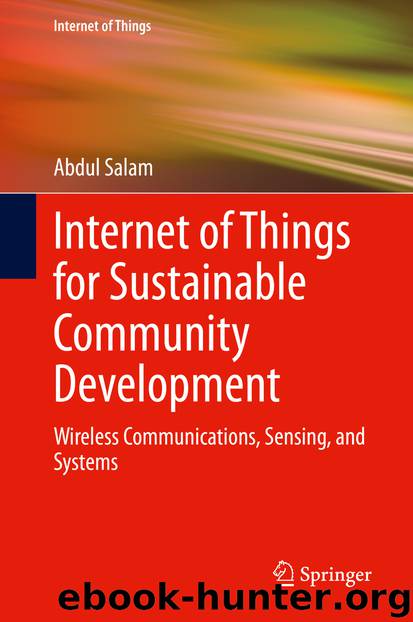Internet of Things for Sustainable Community Development by Abdul Salam

Author:Abdul Salam
Language: eng
Format: epub
ISBN: 9783030352912
Publisher: Springer International Publishing
SAtélite Argentino de Observación COn Microondas (SAOCOM)
L-band active
1 km
NASA-ISRO Synthetic Aperture Radar (NISAR)
Ka-band
200 m
Remote sensing in digital forestry is insufficient due to vegetation thickness. The sensing depth by limited to few centimeters. It further decreases with increase in measurement frequency. Moreover, the vegetation loss also increases with increase in the measurement operation frequency.
The radar and LiDAR based active sensing approaches [61] can also provide useful information. Radar operates at 1.26 GHz frequency with VV, HH, and HV polarization and has resolution of 3 km. The radiometer functions in 1.41 GHz with polarization of H and V, and has resolution of 40 km. Although radar in comparison to radiometer has high spatial resolution (1–3 km) but it is more sensitive to surface roughness and vegetation. There it has limited accuracy in thick forests. However, radiometer has high accuracy because it is less impacted by the surface roughness and vegetation but coarser spatial resolution of 40 km makes it less useful for small geographically separated forests. An alternative of combined radar and radiometer solution gives enhanced results of improved resolution and higher accuracy to meet IoT sensing requirements in digital forestry.
Overall, remote sensing can be used to obtain important data from the forest soils and vegetation. This includes spatial coverage of the vegetation, classification of forests, and soil moisture [61].
Download
This site does not store any files on its server. We only index and link to content provided by other sites. Please contact the content providers to delete copyright contents if any and email us, we'll remove relevant links or contents immediately.
Sass and Compass in Action by Wynn Netherland Nathan Weizenbaum Chris Eppstein Brandon Mathis(7810)
Grails in Action by Glen Smith Peter Ledbrook(7719)
Azure Containers Explained by Wesley Haakman & Richard Hooper(6859)
Configuring Windows Server Hybrid Advanced Services Exam Ref AZ-801 by Chris Gill(6857)
Running Windows Containers on AWS by Marcio Morales(6383)
Kotlin in Action by Dmitry Jemerov(5092)
Microsoft 365 Identity and Services Exam Guide MS-100 by Aaron Guilmette(5078)
Combating Crime on the Dark Web by Nearchos Nearchou(4654)
Microsoft Cybersecurity Architect Exam Ref SC-100 by Dwayne Natwick(4636)
Management Strategies for the Cloud Revolution: How Cloud Computing Is Transforming Business and Why You Can't Afford to Be Left Behind by Charles Babcock(4438)
The Ruby Workshop by Akshat Paul Peter Philips Dániel Szabó and Cheyne Wallace(4342)
The Age of Surveillance Capitalism by Shoshana Zuboff(3983)
Python for Security and Networking - Third Edition by José Manuel Ortega(3901)
The Ultimate Docker Container Book by Schenker Gabriel N.;(3565)
Learn Wireshark by Lisa Bock(3546)
Learn Windows PowerShell in a Month of Lunches by Don Jones(3530)
Mastering Python for Networking and Security by José Manuel Ortega(3376)
Mastering Azure Security by Mustafa Toroman and Tom Janetscheck(3356)
Blockchain Basics by Daniel Drescher(3329)
